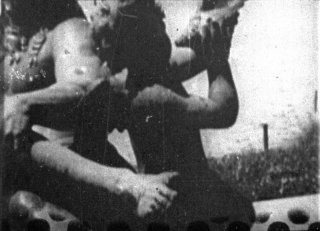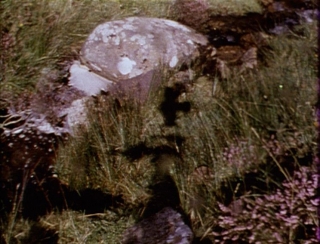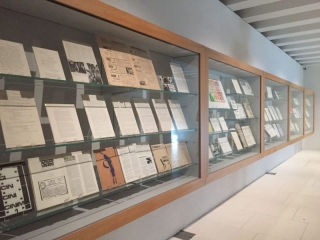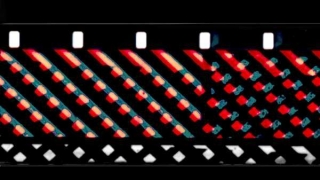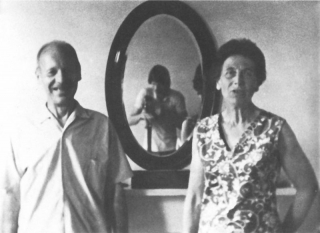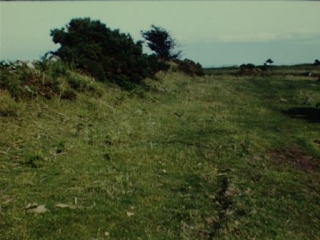Date: 27 May 2008 | Season: Videoex 2008 | Tags: Shoot Shoot Shoot
SHOOT SHOOT SHOOT: 1
Tuesday 27 May 2008, at 6pm
Zurich Videoex Festival Cinema Z3
The London Film-Makers’ Co-operative was established in 1966 to support work on the margins of art and cinema. It uniquely incorporated three related activities within a single organisation – a workshop for producing new films, a distribution arm for promoting them, and its own cinema space for screenings. In this environment, Co-op members were free to explore the medium and control every stage of the process. The Materialist tendency characterised the hardcore of British filmmaking in the early 1970s. Distinguished from Structural Film, these works were primarily concerned with duration and the raw physicality of the celluloid strip.
Annabel Nicolson, Slides, 1970, colour, silent, 11 mins (18fps)
Guy Sherwin, At the Academy, 1974, b/w, sound, 5 mins
Mike Leggett, Shepherd’s Bush, 1971, b/w, sound, 15 mins
David Crosswaite, Film No. 1, 1971, colour, sound, 10 mins
Lis Rhodes, Dresden Dynamo, 1971, colour, sound, 5 mins
Chris Garratt, Versailles I & II, 1976, b/w, sound, 11 mins
Mike Dunford, Silver Surfer, 1972, b/w, sound, 15 mins
Marilyn Halford, Footsteps, 1974, b/w, sound, 6 mins
PROGRAMME NOTES
SHOOT SHOOT SHOOT: 1
Tuesday 27 May 2008, at 6pm
Zurich Videoex Festival Cinema Z3
SLIDES
Annabel Nicolson, 1970, colour, silent, 11 mins (18fps)
“A continuing sequence of tactile films were made in the printer from my earlier material. 35mm slides, light leaked film, sewn film, cut up to 8mm and 16mm fragments were dragged through the contact printer, directly and intuitively controlled. The films create their own fluctuating colour and form dimensions defying the passive use of ‘film as a vehicle’. The appearance of sprocket holes, frame lines etc., is less to do with the structural concept and more of a creative, plastic response to whatever is around.” (Annabel Nicolson, LFMC catalogue 1974)
AT THE ACADEMY
Guy Sherwin, 1974, b/w, sound, 5 mins
“Makes use of found footage hand printed on a simple home-made contact printer, and processed in the kitchen sink. At The Academy uses displacement of a positive and negative sandwich of the same loop. Since the printer light spills over the optical sound track area, the picture and sound undergo identical transformations.” (Guy Sherwin, LFMC catalogue 1979)
SHEPHERD’S BUSH
Mike Leggett, 1971, b/w, sound, 15 mins
“Shepherd’s Bush was a revelation. It was both true film notion and demonstrated an ingenious association with the film-process. It is the procedure and conclusion of a piece of film logic using a brilliantly simple device; the manipulation of the light source in the Film Co-op printer such that a series of transformations are effected on a loop of film material. From the start Mike Leggett adopts a relational perspective according to which it is neither the elements or the emergent whole but the relations between the elements (transformations) that become primary through the use of logical procedure.” (Roger Hammond, LFMC catalogue supplement, 1972)
FILM NO. 1
David Crosswaite, 1971, colour, sound, 10 mins
“Film No. 1 is a 10-minute loop film. The systems of super-imposed loops are mathematically inter-related in a complex manner. The starting and cut off points for each loop are not clearly exposed, but through repetitions of sequences in different colours, in different ‘material’ realities (i.e. a negative, positive, bas-relief, neg-pos overlay) yet in constant rhythm (both visually and on the soundtrack hum) one is manipulated to attempt to work out the system structure … The film deals with permutations of material, in a prescribed manner but one by no means ‘necessary’ or logical (except within the film’s own constructed system/serial.)” (Peter Gidal, LFMC catalogue 1974)
DRESDEN DYNAMO
Lis Rhodes, 1971, colour, sound, 5 mins
“This film is the result of experiments with the application of Letraset and Letratone onto clear film. It is essentially about how graphic images create their own sound by extending into that area of film which is ‘read’ by optical sound equipment. The final print has been achieved through three separate, consecutive printings from the original material, on a contact printer. Colour was added, with filters, on the final run. The film is not a sequential piece. It does not develop crescendos. It creates the illusion of spatial depth from essentially, flat, graphic, raw material.” (Tim Bruce, LFMC catalogue 1993)
VERSAILLES I & II
Chris Garratt, 1976, b/w, sound, 11 mins
”For this film I made a contact printing box, with a printing area 16mm x 185mm which enabled the printing of 24 frames of picture plus optical sound area at one time. The first part is a composition using 7 x 1-second shots of the statues of Versailles, Palace of 1000 Beauties, with accompanying soundtrack, woven according to a pre-determined sequence. Because sound and picture were printed simultaneously, the minute inconsistencies in exposure times resulted in rhythmic fluctuations of picture density and levels of sound. Two of these shots comprise the second part of the film which is framed by abstract imagery printed across the entire width of the film surface: the visible image is also the sound image.” (Chris Garratt, LFMC catalogue 1978)
SILVER SURFER
Mike Dunford, 1972, b/w, sound, 15 mins
“A surfer, filmed and shown on tv, refilmed on 8mm, and refilmed again on 16mm. Simple loop structure preceded by four minutes of a still frame of the surfer. An image on the borders of apprehension, becoming more and more abstract. The surfer surfs, never surfs anywhere, an image suspended in the light of the projector lamp. A very quiet and undramatic film, not particularly didactic. Sound: the first four minutes consists of a fog-horn, used as the basic tone for a chord played on the organ, the rest of the film uses the sound of breakers with a two second pulse and occasional bursts of musical-like sounds.” (Mike Dunford, LFMC catalogue supplement 1972)
FOOTSTEPS
Marilyn Halford, 1974, b/w, sound, 6 mins
“Footsteps is in the manner of a game re-enacted, the game in making was between the camera and actor, the actor and cameraman, and one hundred feet of film. The film became expanded into positive and negative to change balances within it; black for perspective, then black to shadow the screen and make paradoxes with the idea of acting, and the act of seeing the screen. The music sets a mood then turns a space, remembers the positive then silences the flatness of the negative.” (Marilyn Halford, LFMC catalogue 1978)
Back to top
Date: 31 May 2008 | Season: Videoex 2008 | Tags: Shoot Shoot Shoot
SHOOT SHOOT SHOOT: 2
Saturday 31 May 2008, at 6pm
Zurich Videoex Festival Cinema Z3
The 1960s and 1970s were a defining period for artists’ film and video in which avant-garde filmmakers challenged cinematic convention. In England, much of the innovation took place at the London Film-Makers’ Co-operative, an artist-led organisation that incorporated a distribution office, projection space and film workshop. Despite the workshop’s central role in production, not all the work derives from experimentation in printing and processing. Filmmakers also used language, landscape and the human body to create less abstract works that still explore the essential properties of the film medium.
Malcolm Le Grice, Threshold, 1972, colour, sound, 10 mins
Chris Welsby, Seven Days, 1974, colour, sound, 20 mins
Peter Gidal, Key, 1968, colour, sound, 10 mins
Stephen Dwoskin, Moment, 1968, colour, sound, 12 mins
Gill Eatherley, Deck, 1971, colour, sound, 13 mins
William Raban, Colours of this Time, 1972, colour, silent, 3 mins
John Smith, Associations, 1975, colour, sound, 7 mins
PROGRAMME NOTES
SHOOT SHOOT SHOOT: 2
Saturday 31 May 2008, at 6pm
Zurich Videoex Festival Cinema Z3
THRESHOLD
Malcolm Le Grice, 1972, colour, sound, 10 mins
“Le Grice no longer simply uses the printer as a reflexive mechanism, but utilises the possibilities of colour-shift and permutation of imagery as the film progresses from simplicity to complexity … With the film’s culmination in representational, photographic imagery, one would anticipate a culminating ‘richness’ of image; yet the insistent evidence of splice bars and the loop and repetition of the short piece of found footage and the conflicting superimposition of filtered loops all reiterate the work which is necessary to decipher that cinematic image.” (Deke Dusinberre, LFMC catalogue 1993)
SEVEN DAYS
Chris Welsby, 1974, colour, sound, 20 mins
“The location of this film is by a small stream on the northern slopes of Mount Carningly in southwest Wales. The seven days were shot consecutively and appear in that same order. Each day starts at the time of local sunrise and ends at the time of local sunset. One frame was taken every ten seconds throughout the film. The camera was mounted on an Equatorial Stand, which is a piece of equipment used by astronomers to track the stars. Rotating at the same speed as the earth, the camera is always pointing at either its own shadow or at the sun. Selection of image (sky or earth; sun or shadow) was controlled by the extent of cloud coverage. If the sun was out the camera was turned towards its own shadow; if it was in the camera was turned towards the sun.” (Chris Welsby, LFMC catalogue 1978)
KEY
Peter Gidal, 1968, colour, sound, 10 mins
“Slow zoom out and defocus of …” (Peter Gidal, LFMC catalogue 1974)
MOMENT
Stephen Dwoskin, 1968, colour, sound, 12 mins
“One single continuous shot of a girl’s face before, during and after an orgasm. A concentration on the subtle changes within the face – going from an objective look into a subjective one and then back out … Moment is not a woman alone, but with her ‘in person’. Have you ever really watched the face in orgasm?” (Stephen Dwoskin, Other Cinema catalogue 1972)
DECK
Gill Eatherley, 1971, colour, sound, 13 mins
“During a voyage by boat to Finland, the camera records three minutes of black and white 8mm film of a woman sitting on a bridge. The preoccupation of the film is with the base and with the transformation of this material, which was first refilmed on a screen where it was projected by multiple projectors at different speeds and then secondly amplified with colour filters, using positive and negative elements and superimposition on the London Co-op’s optical printer.” (Gill Eatherley, Light Cone catalogue, 1997)
COLOURS OF THIS TIME
William Raban, 1972, colour, silent, 3 mins
“Whilst working on previous time-lapse films, I found that colour film tended to record the actual colour of the light source rather than local colour when long time exposures were used. Using this phenomenon, Colours of this Time records all the imperceptible shifts of colour temperature in summer daylight, from first light until sunset.” (William Raban, LFMC catalogue 1974)
ASSOCIATIONS
John Smith, 1975, colour, sound, 7 mins
“Text taken from ‘Word Associations and Linguistic Theory’ by Herbert H. Clark. Images taken from magazines and colour supplements. By using the ambiguities inherent in the English language, Associations sets language against itself. Image and word work together/against each other to destroy/create meaning.” (John Smith, LFMC catalogue 1978)
Back to top
Date: 10 April 2016 | Season: Shoot Shoot Shoot 2016 | Tags: Shoot Shoot Shoot
SHOOT SHOOT SHOOT
Sunday 10 April 2016, at 3pm
St. Ives Porthmeor Studios
An afternoon of screenings celebrating the first decade of the London Film-Makers’ Co-operative (1966–76), the predecessor of LUX. The LFMC was founded in October 1966 as a non-commercial distributor of avant-garde cinema. In contrast to similar groups that emerged around the world, it grew to incorporate a distribution service, cinema space and film laboratory. Within this unique facility, filmmakers were able to control every aspect of the creative process. Many explored the material aspects of celluloid, whilst others experimented with multiple projection and performance-based ‘expanded cinema’. Despite the physical hardship of its survival, this artist-led organisation asserted the significance of British work internationally, and anticipated today’s vibrant culture of artists’ moving image. The early history of the LFMC will be documented in a display of films and ephemera in the Archive Gallery at Tate Britain (25 April to 17 July 2016), and a book will be published by LUX this autumn.
3pm
Guy Sherwin, At The Academy, 1974, 5 min
Marilyn Halford, Footsteps, 1974, 6 min
Peter Gidal, Key, 1968, 10 min
Annabel Nicolson, Slides, 1970, 12 min (18fps)
Malcolm Le Grice, Berlin Horse, 1970, 8 min
Lis Rhodes, Dresden Dynamo, 1974, 5 min
Chris Garratt, Romantic Italy, 1975, 8 min
John Smith, Associations, 1975, 7 min
5pm
William Raban & Chris Welsby, River Yar, 1971–72, 35 min (double screen projection)
Curated and presented by Mark Webber.
Date: 25 April 2016 | Season: Shoot Shoot Shoot 2016 | Tags: Shoot Shoot Shoot
SHOOT SHOOT SHOOT: THE LONDON FILM-MAKERS’ CO-OPERATIVE 1966-76
25 April—17 July 2016
London Tate Britain Archive Gallery
This display traces the first decade of the London Film-Makers’ Co-operative through a selection of documents, ephemera and films from the period. The LFMC was founded in October 1966 as a non-commercial distributor of avant-garde cinema. In contrast to similar groups that emerged around the world, it grew to incorporate a distribution service, cinema space and film laboratory. Within this unique facility, filmmakers were able to control every aspect of the creative process. Many explored the material aspects of celluloid, whilst others experimented with multiple projection and performance-based ‘expanded cinema’. Despite the physical hardship of its survival, this artist-led organisation asserted the significance of British work internationally, and contributed towards today’s vibrant culture of artists’ moving image.
Curated by Mark Webber. Presented by LUX in association with the British Artists’ Film and Video Study Collection. With thanks to Inga Fraser, David Curtis, Steven Ball, Alejandro Fernandez Moreno, Peter Gidal, William Cobbing and the Cobbing Family Archive.
Date: 13 October 2016 | Season: Shoot Shoot Shoot 2016 | Tags: Shoot Shoot Shoot
SOFT FLOOR, HARD FILM: CELEBRATING 50 YEARS OF THE LONDON FILM-MAKERS’ CO-OP
Thursday October 13 2016, at 7pm
London ICA Theatre
To mark the 50th anniversary, to the day, since the founding of the London Film-makers’ Co-operative (LFMC), LUX launches the new publication Shoot Shoot Shoot: The First Decade of the London Film-Makers’ Co-operative 1966-76, edited by Mark Webber.
Organised in conjunction with Frieze Video and the ICA’s Artists’ Film Club, the evening will feature a newly commissioned short film about the LFMC, produced by Frieze in collaboration with artist and writer Matthew Noel-Todd, who will also chair a discussion with Mark Webber, Malcolm Le Grice and Lis Rhodes on the organisation’s early ideals and ongoing legacy. The panel will be followed by a special presentation of Lis Rhodes’ seminal expanded cinema piece Light Music (1975-77).
The LFMC was established on 13 October 1966. A telegram published in the first issue of the Co-op’s magazine Cinim declared:
“LONDON FILM-MAKERS COOP ABOUT TO BE LEGALLY ESTABLISHED STOP PURPOSE TO SHOOT SHOOT SHOOT SHOOT SHOOT STOP NEVER STOP NO BREAD NO PLACE TO LAY OUR HEADS NO MATTER JUST MIND IF YOU WANT TO MAKE MONEY STOP IF YOU LIKE BRYAN FORBES STOP IF YOU READ SIGHT AND SOUND STOP IF YOU WANT TO MAKE FILMS I MEAN FILMS COME ALL YOU NEEDS IS EYES IN THE BEGINNING STOP GEN FROM 94 CHARING CROSS ROAD W.C.2 PARTURITION FINISHED SCREAMS BEGIN STOP”
The 1960s and 1970s were a defining period for artists’ film and video, and the LFMC was one of its major international centres as an artist-led organisation that pioneered the moving image as an art-form across the UK. Shoot Shoot Shoot: The First Decade of the London Film-Makers’ Co-operative 1966-76 documents its beginnings, tracing its development from within London’s counterculture towards establishing its own identity within premises that uniquely incorporated a distribution office, cinema space and film workshop.
Date: 20 October 2016 | Season: Shoot Shoot Shoot 2016 | Tags: Shoot Shoot Shoot
SHOOT SHOOT SHOOT: THE LONDON FILM-MAKERS’ CO-OP
20 October—1 November 2016
New York Anthology Film Archives
The London Film-Makers’ Co-operative was founded 50 years ago in October 1966. Inspired by the example set by Jonas Mekas and his colleagues in New York, the LFMC grew from its beginnings as a film-viewing group for London’s intellectual counterculture to become of the major centers of a worldwide network of avant-garde film culture. In contrast to similar organizations, the LFMC’s activity was not limited to distribution – within a few years it was also running a regular program in its own cinema and, most notably, democratized the means of production by establishing a film workshop in which filmmakers could control every stage of the creative process.
The work made in this supportive environment was diverse, though two tendencies came to dominate the discourse: structural/materialism and expanded cinema. The materialist qualifier that distinguished British work from the American structural film refers both to Marxist philosophy and the physical presence of the medium that was foregrounded in films produced in the LFMC workshop. European expanded cinema largely eschewed the associations of psychedelia and expanded consciousness as formulated in Gene Youngblood’s book and instead extended the formal exploration of film to the moment of its presentation. The term was used to describe a range of work including multi-screen films, live performances and continuous installations that made innovative use of the mechanics of projection.
Filmmakers associated with the LFMC during its early years include Stephen Dwoskin, Malcolm Le Grice, Peter Gidal, Annabel Nicolson, Sally Potter, Anthony McCall, Lis Rhodes, Guy Sherwin and John Smith. The organization survived in run-down premises, with little or no public funding, for more than thirty years until its enforced dissolution and merger with London Electronic Arts. Since 2002, LUX has distributed the former LFMC collection and promoted its legacy alongside the work of contemporary film and video artists.
Shoot Shoot Shoot: The First Decade of the London Film-Makers’ Co-operative 1966–76, edited by Mark Webber, will be published by LUX in October 2016. The book gathers together texts, images and archival documents and is illustrated throughout in full color.
“Shoot Shoot Shoot: The London Film-Makers’ Co-op”, and the related series “Peter Gidal: Flare Out” and “From Reel to Real”, are presented by Anthology Film Archives in association with LUX, London.
Date: 20 October 2016 | Season: Shoot Shoot Shoot 2016 | Tags: Shoot Shoot Shoot
SHOOT SHOOT SHOOT PROGRAM 1
Thursday 20 October 2016, at 7:30pm
New York Anthology Film Archives
It was the film workshop that set the structure of the LFMC apart from other film co-ops. The facility housed a continuous processor and step printer that enabled filmmakers to work directly with the medium, without the need or expense of commercial laboratories, and provided a set of technical parameters that enabled a school of filmmaking to develop. This program spotlights works that were, more or less, produced within that environment, from the more playful films of Annabel Nicolson and Marilyn Halford, to one of Malcolm Le Grice’s early loop-based found footage meditations on the military/industrial complex. Mike Leggett’s seminal process-piece Shepherd’s Bush, a measured passage from darkness to light, was conceived as a test for the Co-op’s step printer but is nonetheless a cathartic experience for the viewer. Chris Garratt’s Versailles I & II and Lis Rhodes’ dynamic Dresden Dynamo explore the possibilities of using visual imagery to create optical sound on 16mm film.
Annabel Nicolson, Frames, 1973, 16mm, 18fps, color, silent, 8 min
Marilyn Halford, Footsteps, 1975, 16mm, b/w, sound, 7 min
Mike Leggett, Shepherd’s Bush, 1971, 16mm, b/w, sound, 15 min
David Crosswaite, Film No. 1, 1971, 16mm, color, sound, 10 min
Lis Rhodes, Dresden Dynamo, 1971-72, 16mm, color, sound, 4 min
Chris Garratt, Versailles I & II, 1976, 16mm, b/w, sound, 11m
Malcolm Le Grice, Reign of the Vampire, 1970, 16mm, b/w, sound, 16 min
Date: 23 October 2016 | Season: Shoot Shoot Shoot 2016 | Tags: Shoot Shoot Shoot
SHOOT SHOOT SHOOT PROGRAM 2
Sunday 23 October 2016, at 6pm
New York Anthology Film Archives
This second glimpse at the first decade of the London Film-Makers’ Co-op anticipates some of the new directions that followed in later years. Short Film Series is an open-ended set of observational pieces by Guy Sherwin, each the length of a 16mm film roll. Mike Dunford’s Still Life with Pear wittily deconstructs the act of filming, and John Smith constructs a word game of visual puns in Associations. Finally, two double 16mm projection serve as examples of British expanded cinema: Gill Eatherley’s understated feminist ‘room film’, and River Yar, Raban & Welsby’s majestic time-lapse study of a tidal river estuary.
Guy Sherwin, Short Film Series: Vermeer Frames/Chimney/Portrait with Parents/Metronome, 1974-78, 16mm, b/w, silent, 14 min
Mike Dunford, Still Life with Pear, 1973, digital, b/w, sound, 14 min
John Smith, Associations, 1975, 16mm, color, sound, 7 min
Gill Eatherley, Pan Film, 1972, 2 x 16mm, b/w, silent, 8 min
Chris Welsby & William Raban, River Yar, 1972, 2 x 16mm, color, sound, 35 min
Date: 25 October 2016 | Season: Shoot Shoot Shoot 2016 | Tags: Shoot Shoot Shoot
SHOOT SHOOT SHOOT PROGRAM 3
Tuesday 25 October 2016, at 9pm
New York Anthology Film Archives
In the early 1970s, Malcolm Le Grice, Gil Eatherley, William Raban and Annabel Nicolson frequently collaborated on expanded cinema shows under the collective name Filmaktion. In After Manet, all four appear as filmmaker/performers, sharing in a picnic while each operating a 16mm camera according to a set of instructions determined by Le Grice. The resulting images offer different viewpoints on the same event and were shot in permutations of color, black and white, positive and negative. Originally projected as a four-screen simultaneous projection, After Manet is now presented as a HD digital composite. William Raban’s rarely seen film Breath is also a performance within a pastoral landscape. Here, three cameras (operated by Raban, Eatherley and Le Grice) converge on a tape recorder, each shot lasting the duration of a single breath.
William Raban, Breath, 1974, digital, color, sound, 16 min
Malcolm Le Grice, After Manet, After Giorgione – Le déjeuner sur l’herbe or Fête Champêtre, 1974, digital, color, sound, 53 min
Date: 1 November 2016 | Season: Shoot Shoot Shoot 2016 | Tags: Shoot Shoot Shoot
MALCOLM LE GRICE: NEW BFI RESTORATIONS
Tuesday 1 November 2016, at 7:30pm
New York Anthology Film Archives
Malcolm Le Grice instigated the LFMC’s move towards production, building up the workshop and sketching the blueprint for the organization’s structure and constitution in 1968. By that time, he had already constructed the rudimentary printer and developer with which he made his early work. An artist with a passion for technological developments, he was an early adoptee of computer animation, new media and multi-channel work, and is now working in digital 3D. His first 16mm film Castle 1 is a Cageian found-footage assemblage that requires a flashing photoflood lightbulb to be hung in front of the screen. Little Dog for Roger, along with Landow’s Film in Which … and W+B Hein’s Rohfilm, embodies the materialist aspects of structural film. Berlin Horse (music by Brian Eno) and Threshold exhibit Le Grice’s skills as a colorist and After Lumière refashions early cinema to examine the construction of meaning. These five new restorations from the BFI are being shown together for the first time on film.
Malcolm Le Grice, Castle 1, 1966, 35mm, b/w, sound, 22 min
Malcolm Le Grice, Little Dog for Roger, 1967, 35mm, b/w, sound, 12 min
Malcolm Le Grice, Berlin Horse, 1970, 35mm, color, sound, 9 min
Malcolm Le Grice, Threshold, 1972, 16mm, color, sound, 13 min
Malcolm Le Grice, After Lumière – L’arroseur arrosé, 1974, 35mm, b/w, sound, 12 min
